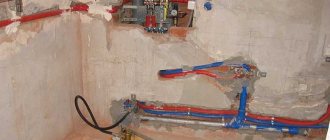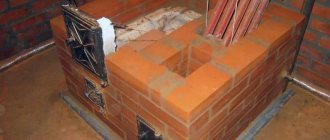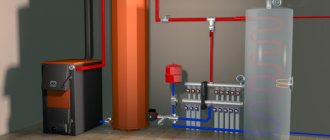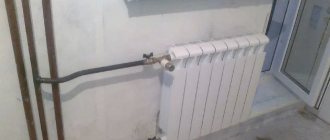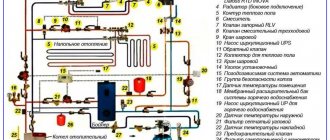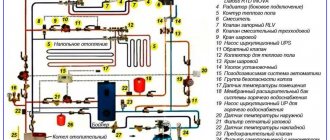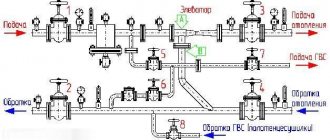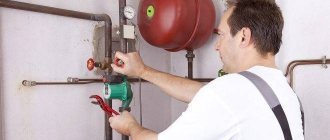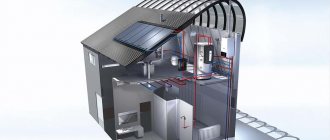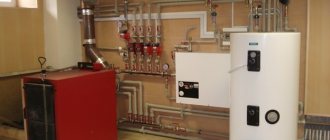Radiator thermostat (heating radiator)
Re: Radiator thermostat (radiator)
Post by Alexandro » Jan 15, 2022, 12:33 pm
Thank you. Tomorrow I will invigorate them.
Re: Radiator thermostat (radiator)
Post by Alexandro » Jan 15, 2022, 12:51 pm
Then I will continue the educational program. It is possible to minimally, but still reduce the heat transfer (checked after yesterday’s setup) of the batteries before installing the thermostat, which Catwoman showed.
You need to remove the red cap and underneath it is the valve/fitting (see picture). To reduce the temperature to a minimum at this stage (before installing the PRADO thermostat), it is necessary to install (by turning the regulator) the unit (symbol “1”) opposite the mark (a certain “notch” (recess) on the body, indicated in the figure as “Installation o7” - provides maximum heat transfer; “N” – factory (average) setting.
Re: Radiator thermostat (radiator)
Post by Opium » Jan 15, 2022, 4:16 pm
Re: Radiator thermostat (radiator)
Post by Alexandro » Jan 16, 2022, 12:51 pm
Convert - addressed. But they don’t have them in stock now. They refuse to give it out.
Re: Radiator thermostat (radiator)
Post by Alexandro » Jan 16, 2022, 02:21 pm
I also figured out the use of red caps (usually they are already installed on the radiator instead of thermostats).
1. Usually the inner white “core” is screwed in all the way like this:
2. What does not allow you to put the cap completely on the threaded valve, it looks like this (the brass thread is clearly visible). The cap turns stupidly and does not reach the thread:
3. It is necessary to unscrew the white core inside the red cap counterclockwise until it stops. Looks like that:
4. Then firmly push the cap onto the valve until it stops (as you can see, the brass thread is now completely covered by the white inner core of the cap):
5. After which the cap is screwed clockwise until it stops and shuts off the water supply by pressing the fitting while screwing it on.
6. When the temperature of the batteries drops to a minimum (about an hour later), by smoothly unscrewing the red cap (counterclockwise), you can gradually increase the temperature to the desired one.
When fully screwed in, the battery is disconnected.
- 02/05/18 Date added 1239 .0 Rating
A comfortable stay indoors is the primary goal of every home/apartment owner. This is most relevant in winter. Creating an optimal temperature regime in a home does not always depend on the work of public utilities, as it might seem at first glance. Even if a system connected to central heating is installed in the apartment, it is possible to change the situation to some extent. How to regulate the temperature in radiators will be discussed in this article.
Contents of the article
How to install correctly
They install a thermostat for a heating radiator at the inlet or outlet of the heating device - there is no difference, they work with equal success in both positions. How to choose a place to install?
According to the recommended installation height. There is such a clause in the technical specifications. Each device is configured at the factory - they are calibrated to control the temperature at a certain height and usually this is the upper radiator manifold. In this case, the heat regulator is installed at a height of 60-80 cm; it is convenient to adjust it manually if necessary.
Installation diagrams for heat regulators for radiators
If you have a bottom saddle connection (pipes fit only from the bottom), there are three options - look for a device that can be installed at the bottom, install a model with a remote sensor, or reconfigure the thermal head. The procedure is simple; the description must be in the passport. All you need is to have a thermometer and at certain moments turn the head in one direction, then in the other direction.
Installation is standard - on fum tape or linen winding with packaging paste
The installation process itself is standard. The valve has a thread. The appropriate fittings are selected for it or a matching thread is cut on the metal pipe.
One important point that those who want to install a thermostat for a heating radiator in apartment buildings should remember. If you have a single-pipe installation, they can only be installed if there is a bypass - a section of pipe that stands in front of the battery and connects the two pipes to each other.
If you have a similar wiring (there may not be a pipe on the right), a bypass is required. The thermostat should be installed immediately behind the radiator
Otherwise, you will regulate the entire riser, which your neighbors will definitely not like. For such a violation, a very substantial fine can be issued. Therefore, it is better to install a bypass (if not).
General points for adjusting temperature in heating radiators
First, you need to determine the essence of the issue under consideration, which will result in a general course of further action. So, a room heating system, regardless of its type, works on the principle of heat exchange between heating elements and air in the room. Most often, this process is achieved using a system of pipes and batteries. A hot coolant circulates inside the elements, which heats the walls of the radiators. From this, further measures to regulate the temperature in the home logically follow.
Produced model ranges
Prado steel heating radiators are presented on the market in several model ranges. There are only four of them, so there will be no agony of choice - everything is extremely easy and simple. For use in children's rooms and medical buildings, it is recommended to pay attention to hygienic samples.
>
The Prado Classic radiator will be a reliable and inexpensive solution for heating your home; the equipment warranty is 10 years.
The Classic series is characterized by a side coolant supply and is equipped with protective side elements and an upper grille. These radiators can be operated at temperatures up to +120 degrees and pressure up to 9 atmospheres. Scope of application – heating of buildings for any purpose (from residential to industrial). The series includes the following types - 33, 30, 22, 21, 20, 11 and 10, height - 300 and 500 mm, length - from 400 to 3000 mm.
Thermal power ranges from 210 to 4874 W for 300 mm high models and from 324 to 7656 W for 500 mm high models. Connection methods: side, bottom side or diagonal, including using thermostatic valves.
Options for changing temperature in heating radiators
There are several ways to accomplish this task, and each of them must be considered separately.
Installation of valves and taps
One of the simplest and most understandable options for adjusting the temperature in radiators is the installation of special valves and valves. The bottom line is that if the temperature in the room is too high, and regulation of the coolant itself is impossible (central heating), then you can reduce its supply to the radiators. This is achieved by installing control valves into the system. Most often, spherical elements are used, which by simple rotation block the flow of coolant inside the batteries. It is worth noting that this option is relevant only if it is necessary to reduce the temperature in the room. Such valves cannot make batteries hotter.
Note! Ball valves are not recommended to be used to partially shut off the flow of water, as this greatly reduces their service life.
Thermal valve - structure, purpose, types
The valve in the thermostat is very similar in structure to a regular valve. There is a seat and a shut-off cone that opens/closes the gap for coolant flow. The temperature of the heating radiator is regulated in this way: by the amount of coolant passing through the radiator.
Sectional view of thermostatic valve
The valves are installed differently for one-pipe and two-pipe wiring. The hydraulic resistance of a valve for a one-pipe system is much lower (at least two times) - this is the only way to balance it. You can't mix up the valves - it won't heat. For systems with natural circulation, valves for single-pipe systems are suitable. When installing them, the hydraulic resistance, of course, increases, but the system will be able to work.
Each valve has an arrow indicating the movement of the coolant. During installation, it is installed so that the flow direction coincides with the arrow.
What materials?
The valve body is made of corrosion-resistant metals and is often additionally coated with a protective layer (nickel or chrome plated). There are valves from:
- bronze (nickel and chrome plated);
- brass (coated with a layer of nickel);
- of stainless steel.
Cases are usually brass or bronze with nickel or chrome plating
It is clear that stainless steel is the best option. It is chemically neutral, does not corrode, and does not react with other metals. But the cost of such valves is high and it is difficult to find them. Bronze and brass valves have approximately the same service life. What is important in this case is the quality of the alloy, and it is carefully monitored by well-known manufacturers. Whether or not to trust unknowns is a controversial issue, but there is one point that is better to keep track of. There must be an arrow on the body indicating the direction of flow. If it is not there, then you have a very cheap product that is better not to buy.
By method of execution
Since radiators are installed in different ways, the valves are made straight (through) and angular. Choose the type that will work best for your system.
Straight (way through) valve and angle
| Name/Company | For which system | Du, mm | Housing material | Operating pressure | Price |
| Danfos, angular RA-G, adjustable | single-pipe | 15 mm, 20 mm | Nickel plated brass | 10 bar | 25-32 $ |
| Danfos, direct RA-G with customizability | single-pipe | 20 mm, 25 mm | Nickel plated brass | 10 bar | 32 – 45 $ |
| Danfos, angular RA-N, adjustable | two-pipe | 15 mm, 20 mm. 25 mm | Nickel plated brass | 10 bar | 30 – 40 $ |
| Danfos, direct RA-N with customizability | two-pipe | 15 mm, 20 mm. 25 mm | Nickel plated brass | 10 bar | 20 – 50 $ |
| BROEN, direct fixed tuning | two-pipe | 15 mm, 20 mm | Nickel plated brass | 10 bar | 8-15 $ |
| BROEN, direct fixed tuning | two-pipe | 15 mm, 20 mm | Nickel plated brass | 10 bar | 8-15 $ |
| BROEN, corner, adjustable | two-pipe | 15 mm, 20 mm | Nickel plated brass | 10 bar | 10-17 $ |
| BROEN, corner, adjustable | two-pipe | 15 mm, 20 mm | Nickel plated brass | 10 bar | 10-17 $ |
| BROEN, direct fixed tuning | single-pipe | 15 mm, 20 mm | Nickel plated brass | 10 bar | 19-23 $ |
| BROEN, fixed angle | single-pipe | 15 mm, 20 mm | Nickel plated brass | 10 bar | 19-22 $ |
| OVENTROP, axial | 1/2″ | Nickel plated brass, enamel plated | 10 bar | 140 $ |
Installation of heating radiators 60-96-58, 8-923-464-96-58
Setting automatic adjustment
Another option for temperature control in radiators is the installation of automatic thermal heads and servos. In essence, such elements are the same valves, but differ in that they operate in automatic mode.
The thermal head is a control device filled with a special compound that responds to temperature changes. It also has a control valve that allows you to set the desired temperature. As a result, when a certain temperature is reached, the composition inside the valve expands, affecting the rod of the inlet three-way valve, and the flow of coolant into the radiator is reduced or interrupted entirely.
When the temperature decreases, the reacting composition contracts and access for the coolant opens. Such devices can be installed either according to the valve principle - built into a pipe, or mounted with a remote sensor.
Another option for automatic temperature control is the installation of servos that control the supply of coolant to a specific battery. It is worth noting that such devices are usually used comprehensively, for example, in smart home systems. The principle of their operation is similar to that used in thermal heads. The difference is that the valve is acted upon using a small electric motor, as a result of which the taps open smoothly, which means the load on the system elements is reduced.
However, you need to understand that the operation of servos is regulated using a system of sensors and a processor that processes information. And this makes this method of adjustment more likely appropriate for an autonomous heating system of a private household. But, in principle, installation is also possible in conditions of centralized heating.
Thermostatic heads
There are three types of thermostatic elements for heating thermostats - manual, mechanical and electronic. They all perform the same functions, but in different ways, provide different levels of comfort, and have different capabilities.
Manual
Manual thermostatic heads work like a regular faucet - you turn the regulator in one direction or another, allowing more or less coolant to flow through. The cheapest and most reliable, but not the most convenient devices. To change the heat transfer, you must manually turn the valve.
Manual thermal head - the simplest and most reliable option
These devices are quite inexpensive, they can be installed at the inlet and outlet of a heating radiator instead of ball valves. Any of them can be adjusted.
Mechanical
A more complex device that maintains the set temperature automatically. The basis of this type of thermostatic head is a bellows. This is a small elastic cylinder that is filled with a temperature agent. A temperature agent is a gas or liquid that has a high coefficient of expansion - when heated, it greatly increases in volume.
Thermostat device for a heating radiator with a mechanical thermostatic head
The bellows supports the rod, which blocks the flow area of the valve. Until the substance in the bellows heats up, the rod is raised. As the temperature rises, the cylinder begins to increase in size (gas or liquid expands), it puts pressure on the rod, which increasingly blocks the flow area. Less and less coolant passes through the radiator, and it gradually cools down. The substance in the bellows also cools down, due to which the cylinder decreases in size, the rod rises, more coolant passes through the radiator, and it begins to warm up a little. Then the cycle repeats.
Gas or liquid
With such a device, the room temperature is fairly maintained at exactly +- 1°C, but in general the delta depends on how inert the substance in the bellows is. It can be filled with some kind of gas or liquid. Gases react faster to temperature changes, but are technologically more difficult to produce.
Liquid or gas bellows - not much difference
Liquids change volumes a little more slowly, but are easier to produce. In general, the difference in the accuracy of temperature maintenance is about half a degree, which is almost impossible to notice. As a result, most of the presented thermostats for heating radiators are equipped with thermal heads with liquid bellows.
Video of one of the methods for adjusting the temperature in radiators
This video provides one way to adjust the temperature in radiators:
Despite the fact that there is a huge range of heating devices on the domestic market, Prado steel heating radiators are very popular among consumers. These heating devices are made of high quality steel and have many other advantages.
In this article we will try to understand in detail why these radiators are attractive.
Conclusion
Prado panel steel radiators are an excellent choice for autonomous heating systems, the pressure in which does not exceed 0.9 MPa. At a low cost, they attract with their quality and attractive appearance.
In addition, the extensive range of these products allows you to select the optimal power of the devices in each individual case. You can get more information on this topic from the video in this article.
Here you will learn:
Radiators are fairly simple heating devices. But their choice comes with some subtleties. By choosing batteries from a little-known brand, consumers risk encountering numerous difficulties, from low efficiency to leaks. By choosing Prado radiators, you can forget about all the problems - at least, this is what many users who have managed to use this equipment think. Our review will be devoted to these radiators.
About company
The company engaged in the manufacture of the radiators in question has a fairly rich history, as it was founded in the city of Izhevsk back in 1959. NITI "Progress" at that time was one of the leaders of engineering and technical thought in the USSR. After the collapse of the Soviet Union, the company underwent reorganization and repurposing.
It should be noted that the production of steel heating radiators at the production facilities of NITI "Progress" was mastered relatively recently - in 2005. It was then that the Prado trademark arose. In parallel with this, a trading house was opened in Izhevsk, the main task of which was to promote Prado radiators on the domestic market.
Today, heating batteries produced under this brand have gained popularity not only in the Russian Federation, but also in other CIS countries. Moreover, the products of the Prado trading house have been repeatedly awarded with cups at industry exhibitions and awarded with diplomas.
Equipment for installation and connection
Prado panel radiators have excellent technical characteristics. They can operate at increased pressure in the line, and a wide range of models allows you to select batteries for the area of the heated premises. In addition to them, Prado produces auxiliary equipment:
It is best to check the cost of radiators, fittings, pipes and other equipment from Prado from official dealers - you will find the lowest prices there.
- Convenient floor mounts that facilitate installation work.
- Thermostatic valves.
- Thermostatic elements.
- Manual control valves.
- Reverse flow valves.
- Bottom connection nodes.
- Plastic and copper pipes.
- Reduction couplings.
- Connectors are straight, triple and angled.
- Fasteners, adapters and much more that is necessary to build a heating system.
Features of Prado batteries
Production
To get an idea of the products in question, you should first familiarize yourself with the production features, which are listed below:
- As mentioned above, Prado batteries are manufactured in factory conditions at facilities . The main raw material for heating appliances is high-carbon steel with a thickness of at least 1.2 - 1.4 mm. The production of radiators begins with cutting steel sheets according to the standard sizes of future radiators.
- Then the blanks are subjected to pressure treatment in a stamping machine, as a result of which they acquire the required profile.
- Two stamped blanks are welded using modern technology, resulting in a panel . Prado heating radiators, depending on the model, may contain one, two or even three such panels, between which ribs made of thinner steel are welded, which increases the heat transfer of the device.
Note! Welding and stamping of workpieces is carried out automatically. This allows not only to significantly improve the quality of products, but also to reduce their price.
Finished products are first painted using the electric dip method, after which they are coated with durable powder paint. Thanks to this, the products not only look attractive, but are also reliably protected from corrosion.
The lineup
Currently, the Prado model range includes six types of radiators:
| Type | Design Features |
| 10 | This model is a single-panel radiator without welded fins. Since the product is the simplest, it has the lowest cost. |
| 11 | A single-panel radiator, unlike the first one, is equipped with a number of fins and end walls. There are grilles for air convection at the top and bottom of the structure. |
| 20 | The product consists of two panels, between which there are channels for air flow. |
| 21 and 22 | They are double-panel radiators, which are equipped with one or two rows of fins. |
| 33 | This model includes three panels and three rows of ribs, making it the most powerful. |
In addition, all radiator models differ in connection type:
- Prado Classic - contain pipes for side connections.
- Prado Universal – designed for lower eyeliner. This modification is equipped with a built-in thermostatic valve and is intended for use in two-pipe systems.
Here, in fact, are all the features of Prado radiators.
